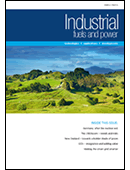Jordan – uranium hotspot
One of the few countries in the Middle East with no oil reserves, Jordan imports around 95 per cent of its energy needs. However, this may well be set to change as the discovery of large quantities of uranium promises a pioneering role for the kingdom in the Middle Eastern nuclear industry. We take a look at Jordan’s progress in developing its nascent nuclear industry.
Jordan is on the brink of an energy crisis if it continues to rely on its current energy generating capacity and technology. In 2006, the country generated 11.6TWh and imported 0.5TWh of electricity for its six million people. Its generating capacity currently stands at around 2400MWe but expects its requirement to reach 3600MWe by 2015 and a doubling in its electricity demand by 2030.
At the basis of this surge in electricity demand lies a mix of burgeoning population – currently at around six million – and the economic expansion of the country, which has led to the proposal of a swathe of infrastructure programmes. Realising this economic potential with its current fuel mix, which is mainly based on imported oil, would leave the kingdom with a considerable energy bill and not bode well for the country’s financial position.
Turning point
However, 2007 proved a turning point as Jordan’s energy minister announced that uranium deposits had been discovered, estimated at 80,000t, excluding a further 100,000t in its phosphate reserves – or two per cent of the global total. The event prompted a swift reversal of energy strategy, which hitherto had been reliant on fossil fuel imports and called for Jordan to be a nuclear-free zone. With encouragement from the US and the International Atomic Energy Authority, the country set on a course to develop its nuclear potential.
As opening gambit, King Abdullah II announced on January 19, 2007 in an interview with the Israeli newspaper Ha’aretz that his country would pursue a peaceful civilian nuclear programme for energy production, thereby positioning the country unequivocally as an emerging nuclear player. The announcement followed similar declarations by other Arab countries in the Middle East, including the GCC, which is considering the construction of a nuclear reactor that will serve the entire region.
Since then, Jordan’s Higher Committee for Nuclear Strategy has developed a programme for nuclear power to supply 30 per cent of electricity by 2030 and to provide for exports. Nuclear energy will also allow for the desalination of vast quantities of water and reduce the country’s dependence on limited winter rainfall, supplying Jordan with that other key commodity scarce within its borders: water. In addition, megaprojects such as the US$5bn Red-Dead Canal would also generate hydropower, driving desalination plants to supply water to its agricultural sector and to its thirsty booming cities.
Jordan’s uranium resources
Latest resource data estimate that Jordan has low-cost uranium resources of 140,000tU. An additional quantity of 59,000tU is locked away in four phosphate deposits, of which Shidia is the largest reserve but holds relatively low levels of uranium, ie averaging 50ppm. The government has announced plans to mine these areas and a feasibility study on recovering uranium as a by-product of phosphoric acid production is being carried out.
In October 2008, the Jordanian-French Uranium Mining Company (JFUMC), a joint venture between JAEC and Areva, was established to define and mine uranium resources in Central Jordan. After nine months of drilling and geological mapping in the 1469km2 concession area, large quantities of high-grade (400ppm) uranium were revealed, located close to surface levels in a 100km2 fertile zone in Sqawa as well as in the Khan Azzabib, Wadi Maghar and Attarat areas. Mining of the combined estimated reserve of 64,880t is envisaged to start in 2012 at a rate of 2000tpa. Areva anticipates that the agreement will lead to further cooperation with JAEC and a bankable feasibility study is the next step towards establishing an open-pit mine.
Large quantities of high-grade uranium were revealed in a 100km2 fertile zone in Sqawa after nine months of drilling and geological mapping by the Jordanian-French Uranium Mining Company.
The discovery of the ore has led to considerable interest from other foreign companies, which are keen acquire a stake in Jordan’s uranium exploration. China National Nuclear Corporation (CNNC) is prospecting for uranium at Hamra-Hausha in the north and Wadi Baheyya in the south.
Rio Tinto is searching in Wadi Sahra Abayad, close to the Saudi Arabian border. In February 2009, the Australian mining giant signed an 18-month agreement with the JAEC to fund the exploration of different areas of Jordan for uranium, thorium and zirconium.
Although foreign companies have assisted in the evaluation of its deposits, it is likely that Jordan’s state-owned company will have exclusive rights to mine and process the material.
No Responses
Leave a Reply
Make sure you enter the * required information where indicated.
You must be logged in to post a comment.

 Click here to read the Q4 2011 Issue of Industrial Fuels & Power
Click here to read the Q4 2011 Issue of Industrial Fuels & Power 

